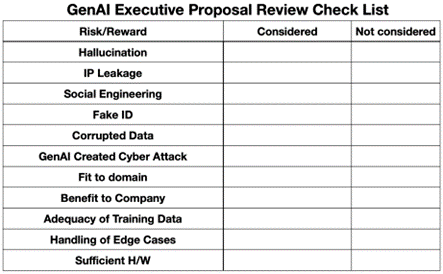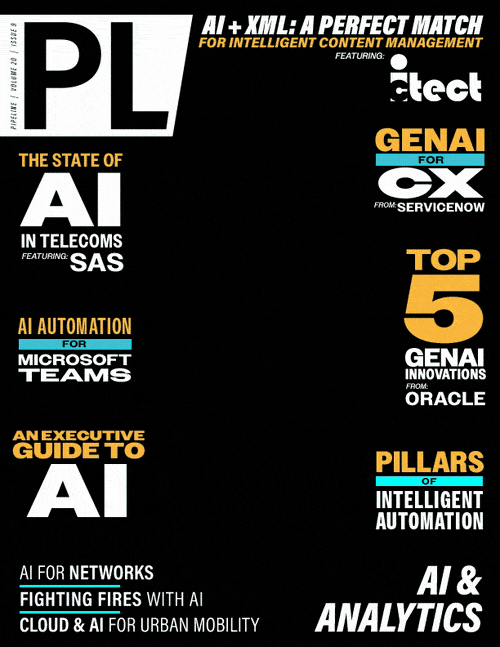An Executive Guide to AI
Illustration 1 has one vertical box: Automation. It is shown as vertical because it touches and interacts with all three of the horizontal boxes. Automation can be used to improve the efficiency and reliability of the infrastructure. It can be used to create, organize, or distribute data. It can be used to help make decisions based on the data. GenAI can participate in automation. One promising application is the use of GenAI to create code used in automation systems.
Risk Check List
Illustration 2 provides a check list that an executive can use with their team to decide whether a proposal being presented by outside partners or internal team members is ready for serious consideration. It first evaluates the risks, then asks about the benefits to the company.

Illustration 2. GenAI Risk/Reward Check List
The risks unique to GenAI derive from GenAI’s negative side effects. The first six items on the check list relate to these risks. For a more detailed discussion of the side effects see The Dark Side of Generative AI: A Taxonomy of Negative Possibilities. By asking questions about these areas of concern the executive can better determine how well thought out and realistic a proposal is.
The next set of questions relate to the domains shown in Illustration 1. They probe how well the proposers understand what they are trying to achieve and if they are doing it in the right domain.
Then comes questions on benefit. There are many stake holders in an enterprise. By asking how the proposal benefits the company, the executive can probe how well the proposers have considered the various affected stakeholders. This then leads to probing what the overall risk/reward ratio is.
Finally come questions about GenAI itself. A GenAI system is only as good as the data it is trained on. Thus, questions about the adequacy of the training data are very important. Related to this are questions about edge cases. Edge cases are the low probability ones that humans are good at dealing with. Some years ago, a Waymo executive explained edge cases with the following example: An autonomous vehicle encounters a semi-trailer painted with a picture, at scale, of a road with a stop sign. A human recognizes this as a picture. But an AI system may get confused. For GenAI systems, the question can come down to whether or not there have been sufficient instances of these edge cases in the training data. Finally, if all the preceding questions have good answers, and there is a good application with a good GenAI system, then the question of resources to run it arises. Is there enough processing power in the right place? Is there enough cooling?
The 11 questions in the illustration 2 check list is a good start. Executives may want to take it as a starting point, perhaps add to it based on their past experience, then update it as they develop and implement the AI innovation ecosystem described below.



















